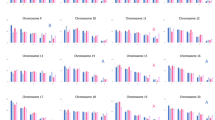Summary
By application of the “centroid” method of Barton, David and Merrington to a number of H3-thymidine radioautographs, it was determined that the human late-replicatingX chromosome lies towards the periphery of the metaphase in a significant number of cases. Further, in agreement with earlier findings by other authors, the centromeres of chromosomes 1, 2 and 3 were found to lie closer together than is to be expected on a random hypothesis.
Similar content being viewed by others
References
Barton, D. E. And David, F. N. (1962). The analysis of chromosome patterns in the normal cell.Ann. Hum. Genet.,25, 323.
Barton, D. E., David, F. N. And Merrington, M. (1964). The positions of the sex chromosomes in the human cell in mitosis.Ann. Hum. Genet.,28, 123.
Barton, D. E., David, F. N. And Merrington, M. (1965). The relative positions of the chromosomes in the human cell in mitosis.Ann. Hum. Genet.,29, 139.
Barton, D. E., David, F. N., Fix, E. And Merrington, M. (1967). A review of analysis of karyographs of the human cell in mitosisin Proceedings of the Fifth Berkeley Symposium on Mathematical Statistics and Probability, L. Lecam and J. Neyman, Eds., University of California Press, Berkeley and Los Angeles,5, 349.
Chandra, H. S. And Hungerford, D. A. (1967). Identification of the human X chromosome: A reconciliation between results obtained from morphological and from radioautographic studies.Ann. Genet.,10, 13.
Mendelsohn, M. L., Conway, T. J., Hungerford, D. A., Kolman, W. A., Perry, B. H. And Prewitt J. M.S. (1966). Computer-oriented analysis of human chromosomes. I. Photometric estimation of DNA content.Cytogenetics,5, 223.
Miller, O. J., Mukherjee, B. B., Breg, W. R. And Gamble, A. V. N. (1963). Non-random distribution of chromosomes in metaphase figures from cultured human leucocytes. I. The peripheral location of the Y chromosome.Cytogenetics,2, 1.
Morishima, A., Grumbach, M. M. And Taylor, J. H. (1962). Asynchronous duplication of human chromosomes and the origin of sex cliromatin.Proc. Nat. Acad. Sci. (U.S.),48, 756.
Ockey, C. H. (1969). The position of chromosomes at metaphase in human fibroblasts and their DNA synthesis behaviour.Chromosoma,27, 308.
Schneiderman, L. J. And Smith, C. A. B. (1962). Non-random distribution of certain homolaegous pairs of normal human chromosomes in metaphase.Nature,195, 1229.
Author information
Authors and Affiliations
Additional information
This work was supported by grants from the World Health Organization, the Indian National Science Academy, grants CA-05903 (now GM-17551) and CA-06927 from the National Cancer Institute, U.S. Public Health Service, and by an appropriation from the Commonwealth of Pennsylvania.
This paper is dedicated to the late Jack Schultz, who to our knowledge was the first to have recognized the phenomenon of scmatic association in human cells. Two of us (H. S. C. and D.A.H.) remain personally indebted to him for sound guidance, generously given, over an interval of many years.
Rights and permissions
About this article
Cite this article
Chandra, H.S., Narayana, A.K.A., Buche, V.V. et al. Peripheral location of the human late X and homologous association of autosomes numbers one, two and three. J Genet 61, 78–83 (1972). https://doi.org/10.1007/BF02984102
Issue Date:
DOI: https://doi.org/10.1007/BF02984102




